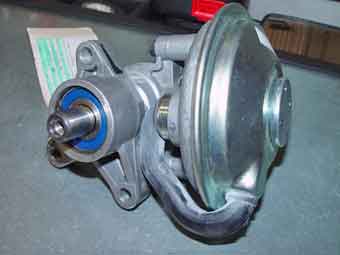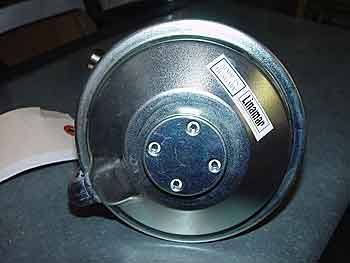Hummer Vacuum Pump
Updated June 8, 2013
 Diesel engines do not make vacuum like a gas engine does. The intake manifold on a diesel is at atmospheric or a positive pressure if it's a turbo. Cars use engine vacuum to run accessories such as power brakes, hvac vents and turbo boost controllers. The Hummer uses a hydroboost braking system that utilizes the power steering pump to supply pressure for the power brakes. Because the hummer needs vacuum to run certain accessories such as the HVAC system, there is a vacuum pump mounted on the engine behind the alternator to supply vacuum. The pump needs to make 22" of vacuum.
Diesel engines do not make vacuum like a gas engine does. The intake manifold on a diesel is at atmospheric or a positive pressure if it's a turbo. Cars use engine vacuum to run accessories such as power brakes, hvac vents and turbo boost controllers. The Hummer uses a hydroboost braking system that utilizes the power steering pump to supply pressure for the power brakes. Because the hummer needs vacuum to run certain accessories such as the HVAC system, there is a vacuum pump mounted on the engine behind the alternator to supply vacuum. The pump needs to make 22" of vacuum.
The Napa part number for 6.5TD engines is 641018. Otherwise get it from AMG.


Replace Vacuum Pump
You are going to need a Pulley Puller and I would go ahead and buy one as you will eventually need it for the Power Steering Pump. A Lisle # 38850 Pulley Puller kit is a pretty good one to buy. These are very common and you can get them at auto supply stores. Here's what one of my readers said; "Don’t be dumb like me and try to remove (and warp) the pulley with a standard pulley remover, but instead use the GM pulley remover designed for the Steering pump pulley."
To make things easier I decided to pull the alternator although you don't have to as you can get to the 3 bolts that hold the Vacuum pump on with a 1/4" drive ratchet and extension thru the holes in the pulley. Then I pulled the vacuum pump which is held in place by 3 - 13 mil bolts. There is a vacuum line that plugs in to the top of the pump which you cannot see with the pump mounted. Make sure to disconnect it. Once the pump is unbolted and the vacuum line is unplugged you can remove the pump. Remove the pulley from the old pump using the puller and transfer it to the new pump.
Reinstalling the pump is just a reversal of the removal. The one thing that I found to be difficult was installing the vacuum line. I un-hooked the line from the source which is under the intake hose that says "no step". My vacuum line was white and covered in split wrap. By un-hooking it from the source you can pull the line down to the pump which makes hooking it up much easier. Just make sure that the vacuum hose is secured to the pump when you install it.
The blower is running but air isn't coming out of the vents or when I change the control the air won't shift between the upper and lower vents.
This is almost always the vacuum pump on trucks with the 97.5 and newer HVAC system. A diesel engine doesn't produce vacuum like a gas engine does so it has a belt driven vacuum pump. This pump drives all the vent doors, the heater valve and the turbo waste gate.
I removed the passenger side kick panel and checked the vent doors. Nothing was moving. I had 5" of vacuum which seemed like it was enough. I went over and checked another hummer and found it had more then 20". Then I looked in the book and it said we should have 22" of vacuum.
You can find a hose to hook a vacuum gauge to near the fire wall on the passenger side. The vacuum pump line runs from the pump which is below the alternator on the passenger side of the truck to the top of the engine where it meets up with the waste gate vacuum solenoid. A vacuum line runs from there to the firewall where is goes to all the HVAC door motors. There is a bundle of thin control lines that continues on across the doghouse to the control unit. Look for pulled out or kinked lines. In some cases the control head or a door actuator is defective.
We installed a new pump and the HVAC worked perfectly. I noticed that my engine sounded different. I have a boost gauge and could see that the engine was getting much more boost then it ever had. I used to pull away from a light and get 4 to 5 psi. Now it shot right up to 8 to 11.

